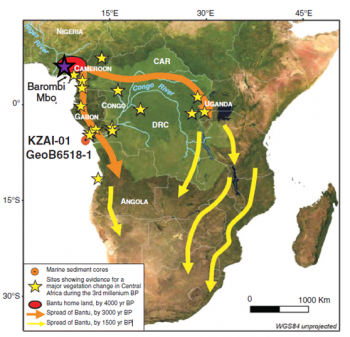Paleoclimate Reconstruction of Western Cameroon, Africa
Kyra Han Kyul Kim

I am interested in reconstructing the paleoclimate history using biomarkers. My research specifically focuses on the climate history of western Cameroon during the 3000-2000 B.P. time frame. Around that time, a huge vegetation disruption is observed from pollen assemblages in west central Africa encompassing the Guinea Coast, Cameroon, and Congo. We see that rainforest species decrease drastically and very abruptly while savanna shrub species increase significantly. Climatologists use this fact to support that there was a huge precipitation change around that time. However, the pollen records only show the presence of a surficial change, not necessarily the reason behind it. Thus this issue becomes tricky to hair out once anthropologists come into the equation: anthropologists and archaeologists have found evidence of the migration of the iron-age Bantu people that coincide with this vegetation disruption of west central Africa. Because of the synchronous nature and similar scale of the migration to the rainforest disruption, the anthropologists assert that mass deforestation by these Bantu people have caused the vegetation change.

To accurately assess the role of climate in this case, we need a climate proxy that is independent of surficial processes. I am working to see the precipitation changes recorded in sediments of Lake Ossa, by observing the hydrogen isotope fractionation trends in long-chain alkanes produced by leaf waxes. All terrestrial vascular plants produce leaf waxes that are made up of straight-chain (or normal, “n-“) n-alkanes, n-alcohols, and n-fatty acids. Alkanes that are straight-chained and have more than 26 carbons are only created by the vascular plants, so they are source-specific and thus are more reliable and readily interpretable. These long-chain alkanes record the hydrogen fractionation values (δD) of the source water, and from the changing trends of δD values, we can understand changes in precipitation trends. This is possible because in tropical regions, the amount effect is the dominant control over the relationship between precipitation amount and its isotopic composition. Heavier precipitation leads to lighter isotopic composition, so we can use this to see if precipitation trends fluctuated beyond the seasonal variability in this region during the time frame of interest. If it did, it is possible that climate did in fact play a role in the vegetation disruption we see from pollen records.
So far, I have extracted all the compounds from the sediments and have separated them my chemical functional groups. I am working to further refine the separated samples using a method called urea adduction, so we can separate out the long-chain alkanes better. After this step I will analyze the isotopic composition of the alkanes and see what interesting climate history is recorded in these alkanes!
Supervisor: Tim Shanahan